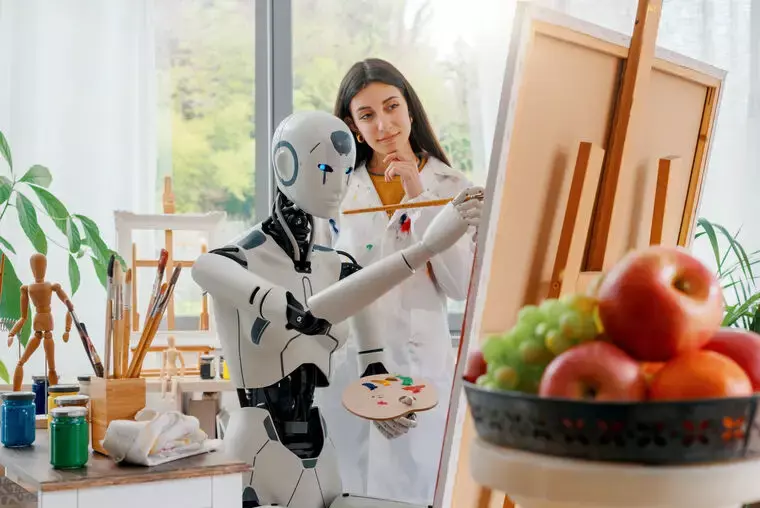Recent research has revealed that Generative Artificial Intelligence (GAI) chatbots, such as ChatGPT versions 3 and 4, Studio.ai, and YouChat, have already reached creativity levels comparable to humans.
The new findings, based on several recently published empirical studies, challenge the long-standing belief that creativity is an exclusive domain of human intelligence.
For years, the general assumption has been that while AI can excel in logical and structured tasks, creativity remains a uniquely human trait. However, a recent study led by Dr. Jennifer Haase from the Department of Computer Science at Humboldt University, Berlin, and Dr. Paul H. P. Hanel from the University of Essex is turning that notion on its head by demonstrating that the line between human and AI-generated creativity is blurring.
In a series of meticulously designed tests, Dr. Haase and Dr. Hanel compared ideas generated by humans with those produced by various GAI chatbots, including prominent names like alpa.ai, Copy.ai, ChatGPT (versions 3 and 4), Studio.ai, and YouChat.
The study employed the Alternative Uses Test (AUT), a standard measure frequently used in creativity tests. Using the AUT, 100 human participants and five general artificial intelligence chatbots were asked to generate original images of five everyday objects, such as pants, a ball, a tire, a fork, or a toothbrush.
The human and GAI-generated responses were then measured based on their originality and fluency of ideas.
What made the research particularly interesting was the assessments of creativity were conducted by humans (following the Consensual Assessment technique) and by an AI program designed explicitly for assessing AUT-trained large-language models. This dual approach was meant to ensure a more comprehensive evaluation of creativity, considering human intuition and AI’s analytical capabilities.
Remarkably, when examining the results, researchers found no significant qualitative difference in the creativity of general artificial intelligence chatbots compared to humans.
These findings are pivotal, suggesting that AI’s potential in creative domains is much broader and more profound than previously thought.
The study showed that although 9.4% of humans surpassed the most creative Generative Artificial Intelligence in the tests, GPT-4, the most recent version of ChatGPT, was notably the highest-performing AI model among those evaluated.
GPT-4’s ability to generate original and creative responses to the prompts underscores the rapid advancements in AI. It also strongly indicates that AI’s role in creative processes is not just supplementary but can be central.
Affirming these findings, another study recently published in the Journal of Creativity found that GPT-4 ranked in the top percentile for originality and fluency on the Torrance Tests of Creative Thinking.
“The creative abilities of AI, including the ability to generate original output, seem to now match human abilities for the first time,” researchers wrote.
The implications of this research are vast and multifaceted, opening up new possibilities for applying GAI in various fields, from artistic creation to problem-solving in business and beyond.
The ability of GAIs to produce creative content that is indistinguishable from human output suggests that we are entering an era where AI can be a collaborator, not just a tool, in creative endeavors.
However, these findings also invite a reevaluation of the role of AI in domains traditionally dominated by human creativity. It raises questions about the uniqueness of human creative expression and the future of creative professions in an increasingly AI-integrated world.
In 2022, fierce debate erupted after a portrait created by the AI program Midjourney won first place in the digital category of the Colorado State Fair’s annual art competition.
Jason M. Allen, who created and entered the hyper-realistic piece of digital art through a series of prompts, was accused by some artists of essentially cheating. Speaking with the New York Times, Allen stood by his submission, noting that he had clearly indicated the work, entitled “Théâtre D’opéra Spatial,” had been created using a generative artificial intelligence chatbot.
“I’m not going to apologize for it,” Allen told the New York Times. “I won, and I didn’t break any rules.”
Previously reported by The Debrief, in September, a group of professional artists penned an open letter to Congress demanding that artists be included in any future discussions involving government policies or regulations on generative AI art.
“AI technology is poised to have massive impacts across all of society,” Tim Boucher, an AI artist and one of the signers of the open letter, told The Debrief. “Consequently, a whole-of-society approach is needed to confront these changes and to direct them into forms which will most benefit humanity and the flourishing of the creative human spirit.”
The discussion about whether Generative Artificial Intelligence chatbots can be genuinely labeled as ‘creative’ is complex and involves subjective viewpoints and varying interpretations of creativity.
“Some critics have argued that chatbots cannot replicate the creativity of humans, as human creativity is a combination of real-world experience, emotion, and inspiration,” Dr. Haase and Dr. Hanel noted in their paper. “However, the definition and common measurement of creativity do not require these elements. It is defined as the ability to produce something new and useful, which can be judged by those engaging with the potentially creative output.”
“Our research showed that their [GAI chatbots] output for a standardized creativity measure for broad-associative ‘thinking’ is as original as the human-generated ideas,” added researchers. “Thus, from a scientific perspective, these chatbots are creative, as their output was judged as such by humans and AI and indistinguishable from human output.”
“In summary, whether GAI is creative can be answered pragmatically with ‘yes, as much or as little as humans.'”
A preprint of “Artificial Muses: Generative Artificial Intelligence Chatbots Have Risen to Human-Level Creativity” has been made available through Arxiv.
Tim McMillan is a retired law enforcement executive, investigative reporter and co-founder of The Debrief. His writing typically focuses on defense, national security, the Intelligence Community and topics related to psychology. You can follow Tim on Twitter: @LtTimMcMillan. Tim can be reached by email: tim@thedebrief.org or through encrypted email: LtTimMcMillan@protonmail.com

